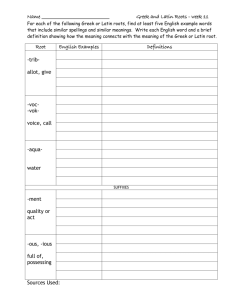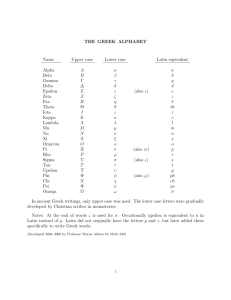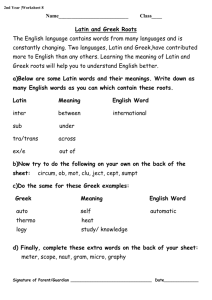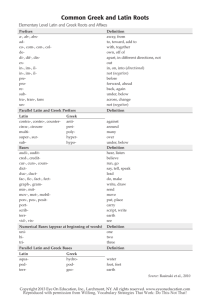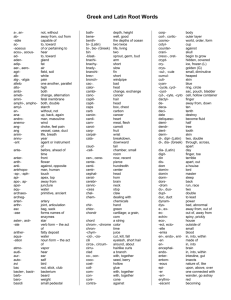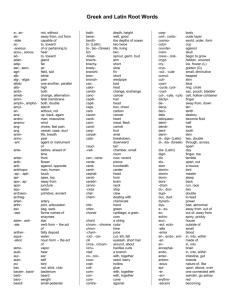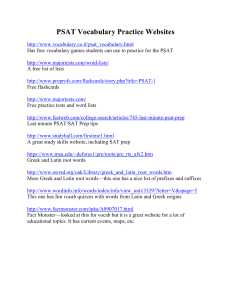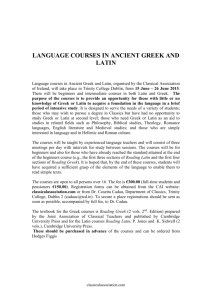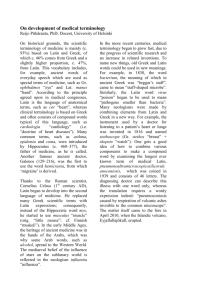HW #1 / Unit 2 Element Names & Symbols – A History of Discovery
advertisement
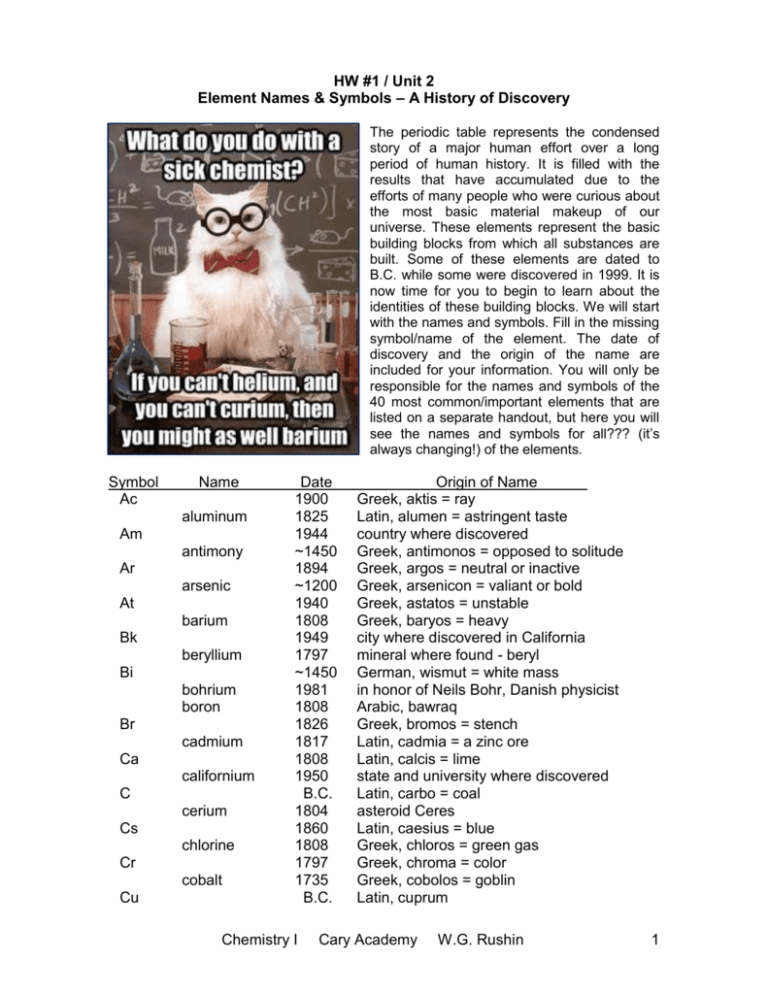
HW #1 / Unit 2 Element Names & Symbols – A History of Discovery The periodic table represents the condensed story of a major human effort over a long period of human history. It is filled with the results that have accumulated due to the efforts of many people who were curious about the most basic material makeup of our universe. These elements represent the basic building blocks from which all substances are built. Some of these elements are dated to B.C. while some were discovered in 1999. It is now time for you to begin to learn about the identities of these building blocks. We will start with the names and symbols. Fill in the missing symbol/name of the element. The date of discovery and the origin of the name are included for your information. You will only be responsible for the names and symbols of the 40 most common/important elements that are listed on a separate handout, but here you will see the names and symbols for all??? (it’s always changing!) of the elements. Symbol Ac Name aluminum Am antimony Ar arsenic At barium Bk beryllium Bi bohrium boron Br cadmium Ca californium C cerium Cs chlorine Cr cobalt Cu Date 1900 1825 1944 ~1450 1894 ~1200 1940 1808 1949 1797 ~1450 1981 1808 1826 1817 1808 1950 B.C. 1804 1860 1808 1797 1735 B.C. Chemistry I Origin of Name Greek, aktis = ray Latin, alumen = astringent taste country where discovered Greek, antimonos = opposed to solitude Greek, argos = neutral or inactive Greek, arsenicon = valiant or bold Greek, astatos = unstable Greek, baryos = heavy city where discovered in California mineral where found - beryl German, wismut = white mass in honor of Neils Bohr, Danish physicist Arabic, bawraq Greek, bromos = stench Latin, cadmia = a zinc ore Latin, calcis = lime state and university where discovered Latin, carbo = coal asteroid Ceres Latin, caesius = blue Greek, chloros = green gas Greek, chroma = color Greek, cobolos = goblin Latin, cuprum Cary Academy W.G. Rushin 1 curium Db Dy einsteinium Er europium Fm fluorine Fr gadolinium Ga germanium Au hafnium Hs He holmium H indium I iridium Fe krypton La lead Li lawrencium Lu magnesium Mn Mt mendelevium Hg molybdenum Nd neon Np nickel Nb nitrogen No osmium O palladium P platinum Pu polonium K 1944 1967 1886 1952 1843 1900 1953 1886 1939 1886 1875 1886 B.C. 1922 1984 1895 1879 1766 1863 1811 1804 B.C. 1898 1839 B.C. 1817 1961 1905 1803 1774 1982 1955 B.C. 1782 1885 1898 1940 1750 1801 1772 1957 1804 1771 1803 1669 1735 1940 1898 1807 Chemistry I in honor of Marie and Pierre Curie discovered in Dubna, Russia Greek, dysprositos = hard to get at in honor of Albert Einstein city, Ytterby, Sweden continent where discovered in honor of Enrico Fermi Latin, fluere = to flow native country of its discoverer in honor of J. Gadolinium, Finnish chemist Latin name, Gaul, of France country, Germany Latin, aurum Latin name of Copenhagen, Denmark relates to Latin name for German state “Hassias” Greek, helios = the sun Stockholm, Sweden, the source of its ore Greek, hydro genes = water former color of its main spectral line Greek, iodos = violet color Latin, iridis = rainbow Latin, ferrum Greek, kryptos = hidden Greek, lanthanein = to be concealed Latin, plumbum Greek, lithos = stone in honor of E. Lawrence, cyclotron inventor Lutetia, ancient name of Paris Latin, magnesia = a place in Asia Minor Latin, magnes = magnet in honor of Lise Meitner, Austrian physicist in honor of D. Mendeleev, father of periodic table Latin, hydragyrum = god and planet Greek, molybdos = lead Greek, neo = new and didymos = twin Greek, neo = new planet German, goblin Niobe, daughter of Tantalus Latin, nitro = native soda and gen = born in honor of Alfred Nobel, inventor of dynamite Greek, osme = a certain odor Greek, oxys = sharp and gen = born planetoid, Palas, discovered in 1801 Greek, phosphoros = light bringer Spanish, plata = silver planet native country of its discoverer Latin, kalium Cary Academy W.G. Rushin 2 praseodymium 1885 1847 protactinium 1917 Ra 1898 radon 1900 Re 1924 rhodium 1804 Rb 1860 ruthenium 1805 Rf 1964 Sm 1879 scandium 1879 Sg 1974 Se 1817 silicon 1823 Ag B.C. sodium 1807 Sr 1808 sulfur B.C. Ta 1802 technetium 1937 Te 1782 terbium 1843 Tl 1862 thorium 1819 Tm 1879 tin B.C. Ti 1791 tungsten 1783 Uub (112) 1996 Uuh (116) 1999 Uun (110) 1994 Uuo (118) 1999 Uuq (114) 1998 Uuu (111) 1994 U 1789 vanadium 1830 Xe 1808 ytterbium 1905 Y 1843 zinc B.C. Zr 1824 Pm Chemistry I Greek, praese = green and didymos = twin Greek mythology, fire bringer Greek, protos = first and actinium Latin, radius = ray originates from radium Latin name of province in Germany Greek, rhodos = rose Latin, rubidius = red Latin name of Russia in honor of Lord Rutherford, New Zealand chemist Samarski, a Russian engineer Scandanavian peninsula by its discoverer Glenn Seaborg, American chemist Greek, selene = the moon Latin, silex = flint Latin, argentum Latin, natrium town of Strontian, Scotland Latin, sulphur Tantalus of Greek mythology Greek, technetes = artifical Latin, tellus = earth Ytterby, Sweden Greek, thallus = a young shoot Thor of Scandinavian mythology Latin, thule = most northerly part Latin, stannum Greek mythology, first sons of earth Swedish, heavy stone temporary systematic IUPAC name temporary systematic IUPAC name temporary systematic IUPAC name temporary systematic IUPAC name temporary systematic IUPAC name temporary systematic IUPAC name planet Uranus Scandinavian mythology, goddess Vanadis Greek, xenos = strange Ytterby, Sweden Ytterby, Sweden German, zink = like tin Arabian, zerk = a precious stone Cary Academy W.G. Rushin 3 Fill in the missing element names. Driving along with a (Fm) ___________ grip on the wheel of his car, a (Ag) __________ (Hg) ____________ with (Cr) ___________ wheels and (Fe-NiMn-C) _________-belted (Ra) ___________ tires, he was on his way to southern (Cf) _______________. On the way, he had to pull into a gas station in (Bk) _________________ where he bought twenty (Ga) ___________s of (Pb) _____free gas for a (Ni) _________. Just as he pulled out of the station, along came a (Eu) ___________ in his little (Ge) _____________-made car driving on the wrong side of the (Rh) _________. They crashed! The poor fellow hit his (Ne) _____ the dash and bit his (W) __________. As he lay there, a (Si) _________ came along and stole his (Au) ______ watch and left him there to (S) _________. Then, along came an (As) _________ who set fire to his car. Finally, a good (Sm) _____________ came along and tried to (He) ________, but, alas, all he could do was (Ba) __________ in a (Kr) ___________ the hill nearby. Find the element that fits the phrase. __________ What are doctors for? __________ To spice __________ What torpedoed ships do __________ "Get him" __________ Policeman __________ Have went (poor grammar) __________ Well driller's chant __________ Half a dime __________ To press a shirt __________ Directed (past tense) __________ Kitchen work area __________ Leg joint above the calf __________ Amusing prisoner __________ Not fat __________ Building to store autos __________ Holmium x 1/2 __________ The Lone Ranger's horse __________ What I do when hungry __________ What police do to a place if they hear of illegal activity there __________ Cowboy's call after a good trip on a bronco: "I ________" __________ Cowboy's call after a bad trip on a bronco: "I'm _______" __________ What you do to a steak when you barbecue it __________ "_____ anything, but give them nothing." __________ Why she wears My Sin perfume __________ Except science, what all my classes do __________ What I do is none of your ________ ! __________ Soldier from Troy who only fights after dark Chemistry I Cary Academy W.G. Rushin 4
